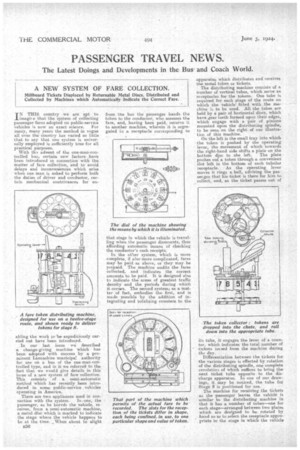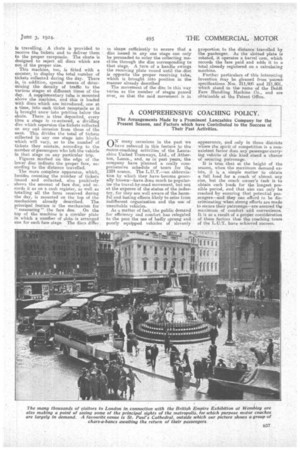PASSENGER TRAVEL NEWS.
Page 20

Page 21

If you've noticed an error in this article please click here to report it so we can fix it.
The Latest Doings and Developments in the Busand Coach World.
A NEW SYSTEM OF FARE COLLECTION.
Millboard Tickets Displaced by Returnable Metal Discs, Distributed and Collected by Machines which Automatically Indicate the Correct Fare.
IN THIS country we are apt to intagir e that the system of collecting passenger fares adopted on public-service
vehicles is now an exact science. For many, many years the method in vogue all over the country has varied so little that to say that one system is universally employed is sufficiently true for all practical purposes.
With tin advent of the one-man-contrelled bus, certain new factors have been introduced in connection with the matter of fare collection, and to avoid delays and inconvenasnces which arise when one man is asked to perform both the duties of driver and conductor, certain mechanical contrivances for en abling the work Lobe expeditiously carried out have been introduced.
In our last issue we described a change-giving machine which has been adopted with success by a prominent Lancashire municipal authority for use on a bus of the one-man-controlled type, and in it we referred to the fact that we would give details in this issue of a. new system of fare collection. This consists of a semi-automatic method which has recently been introduced in. seine public-service vehicles operating in 'America.
There are two appliances used in con nection with the system. In .one, the passenger, as he boards the vehicle, receives, from a semi-automatic machine, a metal disc which is marked to indicate the stage where the vehicle happens to be at the time. _When about to alight B36 from the bus the passenger hands the token to the conductor, who assesses the fare, and, having been paid, returns it to another machine, wherein it is segregated in a receptacle corresponding to that stage in which the vehicle is travelling when the passenger dismounts, thus affording automatic means of checking the conductor's cash receipts. In the other system, which is more complete, if also more complicated, fares may be paid as above, or they may be prepaid. The machine audits the fares collected, and indicates the correct amounts to be paid. It is designed also to indicate the areas of greatest traffic density and the periods during which it occurs. The second system1 as a matter of fact, embodies the first, and is made possible by the addition of integrating and totalizing counters to the
apparatus which distributes and receives the metal token or tickets.
The distributing machine consists of a number of -vertical tubes, which serve as receptacles for the tokens. One tube is required for each stage of the route on which the vehicle' fitted with the machine is to be used. All the tubes are held by a pair of horizontal discs, which have gear teeth formed upon their edges, which engage with a. pair of pinions mounted upon the distributing spindle, to be seen on the right, of our illustration of this machine.
On the left is the small tray into which the token is pushed by the operating lever, the movement of which towards the right-hand side shifts -a plate on the bottom djsc to the left. The plate pushes out a token through a convenient slot left in the bottom of each tubular receptacle. As the operating lever moves it rings a bell, advising the pas. sauger that his ticket is there for him to collect; and, as the ticket passes out of its tube, it engages the lever of a counter, which indicates the total number of tickets issued from the machine during the day.
Differentiation between the tickets for the various stages is effected by rotation of the distributing spindle, one complete revolutiou of which suffices to bring the next ticket tube opposite to the discharge apparatus. In one of our drawings, it may be noticed, the tube for Stage 8 is positioned for use. The machine for receiving the tickets as the passenger leaves the vehicle is similar to the distributing machine in that it has a number of tubes—one for each stage—arranged between two plates which are designed to be rotated by hand so as to select the receptacle appropriate to the stage in which the vehicle
is travelling. A chute is provided to receive the tickets and to deliver them to the proper receptacle. The chute is designed to reject all discs which are not of the proper size.
This machine, too, is fitted with a counter, to display the total number of tickets collected during the day. There is, in addition, special means of determining the densityof traffic to the various stages at different times of• the day. A supplementary tube is mounted above the machine, and this is loaded with discs which a-re introduced, one at a time, into each ticketreceptacle as it is brought anew into petition below the chute. There is thus deposited, every time a stage is re-entered, a dividing disc which separates the tickets collected on any on6 occasion from those of the next,. This divides the total of tickets collected in any one stage into blocks which will vary, as to the number of tickets they contain, according to the number of passengers who left the vehicle in that stage on any particular trip.
Figures marked on the edge of the lower disc indicate the proper fare, according to the distance travelled.
The more complete apparatus which, besides counting the number of tickets issued and collected, also positively shows the amount of fare due; and records it as on a.cash register, as well as totalling all the fares received during the clay, is mounted on the top of the medhaniam already described. The principal feature is the mechanism for measuring" the fare due. On the top of the machine is a circular plate in which a number of slcits is arranged one for each fare sta-g. The discs differ in shape sufficiently to ensure that a disc issued in any one stage can only be persuaded to enter the collecting madine through the disc corresponding to that stage. A turn of a handle swings the receiving plate 'round until the disc is opposite the proper receiving tube, which is 'brought into position in the manner already described
The movement of the disc in this way -varies as the number of stages passed over, so that the said movement is in
proportion to the distance travelled by the pas4enger. As the slotted plate is rotated, it operates a barrel cam, which records the fare paid and adds it to a total already registered on a calculating machine.
Further. particulars of this interestiog invention may be gleaned from patent specifications Nos. 211,900 and 211,901, which stand in the name of the Doldt Fare Handling Machine Co., and are obtainable at the Patent Office.






























